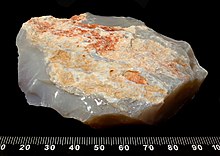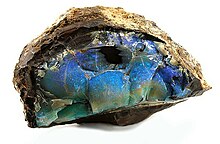Opalescence


Opalescence or play of color is the
Definition
Each of the three notable types of opal – precious, common, and fire[3] – display different optical effects; therefore, the intended meaning varies depending on context.
- The general definition of opalescence is a milky iridescence displayed by an opal, which describes the visual effect of precious opal very well, and opalescence is commonly used in lay terms as a synonym for iridescence.[4]
- In contrast, common opal does not display an iridescence, but often exhibits a hazy sheen of light from within the stone – the phenomenon that gemologists strictly term as opalescence.[5] This milky sheen displayed by opal is a form of adularescence.[6]
- Fire opal is a relatively transparent gemstone with a vivid yellow-orange-red color and rarely displays iridescence.[2]
Mechanism
The optical effects seen in various types of opal are a result of
silica spheres are relatively small, refracted blue-green colors are prevalent; when relatively larger, refracted yellow-orange-red colors are seen; and when larger yet, reflection yields a milky-hazy sheen.[2][6]

In a physical sense, some cases of opalescence could be related to a type of dichroism seen in highly dispersed systems with little opacity. Due to Rayleigh scattering, a transparent material appears yellowish-red in transmitted white light and blue in the scattered light perpendicular to the transmitted light.[7] The phenomenon illustrated in the bottom photo is an example of the Tyndall effect.
See also
- Aventurescence
- Labradorescence
- Moonstone (gemstone)
References
- ^ opalescent. 2019. In Noah Webster's 1828 American Dictionary of the English Language. Retrieved January 7, 2019, from https://1828.mshaffer.com/d/word/opalescent
- ^ a b c d "Opal Gemstone Information". Gemstone Select. 2018. Retrieved 2019-01-08.
- ^ a b Douma, M., curator. 2008. Opal. In Cause of Color. Retrieved January 8, 2019, from https://webexhibits.org/causesofcolor/15F.html
- ^ "opalescent". Merriam-Webster.com Dictionary. Retrieved 2019-01-08.
- ^ "Opal Description". Gemological Institute of America. 2019. Retrieved 2019-01-08.
- ^ a b Smigel, Barbara W. 2012. Optical Phenomena in Gemstones. In Introduction to Gemology. Retrieved January 8, 2019, from http://www.bwsmigel.info/Lesson6/DE.Optical.Phenomena.html
- ^ a b Douma, M., curator. (2008). Blue and Red. In Cause of Color. Retrieved 2005 from http://www.webexhibits.org/causesofcolor/14B.html
